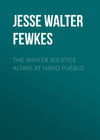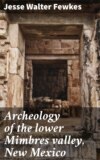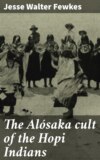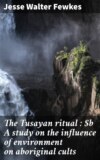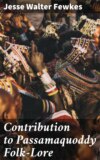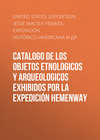Kitabı oku: «The Winter Solstice Altars at Hano Pueblo», sayfa 4
The clay effigy of the Great Snake was next placed back of the rain-cloud symbols, with the head pointing southward. As this effigy lay on the floor, Anote made on it, with meal, representations of eyes and teeth, then drew two lines of meal about the neck for a necklace, and two other parallel lines about the tail. Black powder was then evenly sprinkled along the back of the effigy.
Both Anote and Satele procured a few ears of differently colored corn and shelled them upon the rain-cloud picture, sprinkling the grains evenly over the meal design, and adding a few to the back of the Great Snake. Squash and melon seeds were likewise distributed in the same way. The vase from which the stone effigies and other images were taken was then placed near the base of the middle rain-cloud picture, and a large quartz crystal was added on the left. A conch, which the author presented to the chief, was placed on the right of this vase. Anote then swept the floor north of the fireplace, and as he sang in a low tone Satele drew a straight line of meal from near the right pole of the ladder across the floor to the middle of the altar. He placed along this line, at intervals, four feathers, and near where it joined the altar he stretched a string, with an attached feather, called the pütabi.29 He then sprinkled a line of pollen along this trail of meal.
Anote's medicine-bowl was set just in front of the middle rain-cloud figure; the clay pedestal with inserted upright feathers stood before the left, and a basket-tray with prayer-meal before the right rain-cloud figure.
Altar in the Tewakiva at Hano
The altar (plate XIX) in the Tewakiva was begun about 10 A.M. on the Assembly day, and was made by Pocine,30 assisted by his uncle, Puñsauwi, both members of the Nañ-towa, or Sand clan.
The preparations began with the manufacture of a clay effigy of the Great Snake similar to but larger than that made by Anote in the Moñkiva. The clay was moistened and kneaded on the floor, and then rolled into a cylinder about three feet long, blunt at one end and pointed at the other.
Four clay balls were made at the same time. One of these later served as the base of a standard (natci) which was subsequently placed each morning on the kiva hatch to warn the uninitiated not to enter. The other three were placed back of the altar and supported the sticks called the altar-ladders, which will be considered later.
Pocine outlined with meal on the floor a square figure which he divided into two rectangular parts by a line parallel with the northern side. He used meal of two colors – white for one rectangle, and light brown or pinkish for the other. Having made the outlines of the rectangle with great care, he carelessly sprinkled the enclosed spaces with the meal, hardly covering the sand base upon which the figures were drawn. He then added four triangular figures in meal on the south or front side of the rectangular symbols. These images represented rain-clouds, and were alternately white and brown.31 To the tips of these triangular rain-cloud figures he appended zigzag continuations with lozenge-shaped tips representing the lightning of the four cardinal points. A stone spearpoint or arrowhead was laid on each lozenge-like tip of the zigzag lightning.32
The two men, Pocine and Puñsauwi, next raised the snake effigy and bore it to a position back of the rectangular meal figures on the floor. They deposited it in such a way that its head pointed southward. Having set the snake effigy in the position which it was to retain throughout the ceremony, Pocine sprinkled a black powder along the back of the image, while his uncle inserted several kernels of corn in the blunt end to represent sent the teeth of an upper jaw. Two kernels of corn were then stuck into the head to indicate eyes, and an imitation necklace, also of grains of corn, was made around the neck of the idol. A double encircling row of corn grains was inserted in the tail or pointed end of the effigy, and Pocine added a small feather at the tip.
After the effigy had been put in position and adorned in the manner described, both Pocine and his uncle again shelled ears of corn on the rectangles of meal,33 to which were added squash, melon, and other seeds. These were regularly distributed, some being dropped along the back of the image.
A row of eagle feathers was now inserted along the back of the effigy, instead of in a ridge of sand as in the Moñkiva altar. There were twelve of these feathers, and they were placed at equal intervals from the neck to the tail of the effigy. Puñsauwi then placed the three balls of clay, previously mentioned, back of the image, and in each of these balls he inserted two sticks, called pahos, similar to those used on the altar of the Moñkiva. These are ancient objects, being reputed to have descended from a remote past. One stick in each pair was called the male, the other the female, as is true of all double prayer-sticks used by the Hopi Indians. They are called poñya-saka, "altar-ladders," and imitations34 of them in miniature are made and placed in shrines on the final day of the ceremony.
The insertion of the row of eagle-feathers along the back of the clay effigy of the serpent recalls an instructive reptilian figure on one of the bowls from Sikyatki.35 In this ancient pictograph we find a row of triangles drawn along the medial line from the head to the tail of a lizard-like figure. The use of the triangle in ancient Pueblo pictography as a symbol of a wing-feather, has been pointed out in an article on the feather as a decorative design in ancient Hopi pottery.36 The medial line of triangles, representing feathers, on the Sikyatki food-bowl, is paralleled in the Hano kiva by eagle-wing feathers inserted along the middle of the image of a snake.
A small vase was next placed just in advance of the effigy of the Great Snake, and into this vase Pocine poured water from an earthenware canteen, making a pass as he did so to the four Pueblo cardinal points – north, west, south, and east – in sinistral ceremonial circuit.37 A stone arrow-point was then laid on the lozenge-shaped extremity of each lightning figure.
Pocine now scraped into the vase some powder from a soft white stone, saying, as he did so, that the process was called sowiyauma, "rabbits emerge,"38 and that he wished he had stones of other colors, corresponding to the cardinal points, for the same purpose. After this was finished he emptied on the floor, from a cloth bag, a miscellaneous collection of botryoidal stones (many of which were waterworn), a few fetishes, and other objects, one of the most conspicuous among the latter being a large green stone. All were at first distributed on the meal picture without any special order, but later were given a definite arrangement.
Pocine next went up the kiva ladder, and standing on the upper rung in the sunlight, sought, by means of an angular piece of glass, to reflect a ray of sunlight on the altar, but more especially into the vase of medicine. Four turkey-feathers were then inserted at equal intervals along the base of the serpent effigy, as shown in plate XIX.
After the stone objects had been arranged on the meal picture, a line of meal was drawn along the floor, from the right pole of the ladder to the altar. This line was drawn with great care, particular pains being taken to make it as straight as possible. There was no singing while this occurred, thus differing from the ceremony performed in the other Hano kiva. Four small feathers were placed at intervals along the line of meal. These, in sequence, beginning with the one nearest the ladder, were sikyatci, yellow-bird; kwahu, eagle or hawk; koyoña, turkey; and pociwû. Pocine sprinkled pollen along this line or meal trail.
There was then emptied from a canvas bag upon the rectangular meal figures a heterogeneous collection of objects, among which may be mentioned a bundle of gaming reeds, the humerus of a turkey, a whistle made of a turkey bone, and a zigzag wooden framework such as is used by the Hopi to represent lightning.39
Back of the altar, leaning against the wall of the kiva, was set upright a wooden slat, notched on both edges and called tawa-saka, "sun-ladder." Miniature imitations (plate XX) of this are made in this kiva on the last day of the Tûñtai and deposited in a shrine near Sikyaowatcomo, the site of the early settlement of the Tewa. The poñya-saka or tawa-saka mentioned has not before been seen in any Hopi ceremony, and it may be characteristic of Tewa altars. A notched prayer-stick, called the rain-cloud ladder, is placed in the same shrine at this time. This is characteristic of the Tewa of Tusayan, but is not found in the Hopi pahos, with which I am familiar.40
The reason these prayer-sticks are termed "ladders" is because they have the form of an ancient type of ladder made by notching a log of wood. They are symbols of the ladders by which the Sun is supposed to emerge from his house at sunrise. In the Hopi and Tewa conception the Sun is weary as he withdraws to the south in winter and these ladders are made to aid him in rising, and thus in returning to bless them. More light will doubtless be shed on the significance of the sun-ladder prayer-offerings when we know more of the ceremonies about the Tûñtai altars.
No típoni or badge of office was placed on this altar on the day it was made, and my abrupt departure from the East Mesa made it impossible for me to see the rites which are later performed about it.
It is evident, from the preceding description, that the priests of Hano have a knowledge of the Great Serpent cult corresponding to the worship of Palülükoñ. Among the Hopi the Patki people claim to have introduced this cult41 in comparatively recent times. There is a Tewa clan called Okuwuñ (Cloud) which corresponds, so far as meaning goes, with the Patki clan of the Hopi. Whether this clan brought with it a knowledge of the Great Snake is not clear, as traditions are silent on that point.
